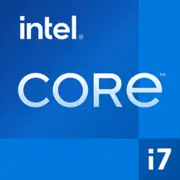Intel Core i7-9700K

Intel Core i7-9700K: Comprehensive Review of the 2025 Processor
Despite the release of new generations of CPUs, the Intel Core i7-9700K remains in high demand among gamers and users who value stability. Let's explore why this 8-core processor is still relevant in 2025.
Key Specifications: Coffee Lake Architecture and Performance
Released in 2018, the processor is built on the Coffee Lake-S architecture (14 nm++). Its key features include:
- 8 Cores / 8 Threads — no Hyper-Threading, but high clock speed (base — 3.6 GHz, turbo boost — 4.9 GHz).
- 12 MB L3 Cache — improved task predictability.
- Integrated Graphics UHD 630 — suitable for office PCs or emergencies when the discrete graphics card fails.
- TDP 95 W — moderate power consumption, but requires good cooling when overclocking.
Performance:
- In Geekbench 6 (2025), the CPU scores 1662 points in single-core and 7077 in multi-core tests. This performance level is sufficient for most modern games (for instance, Cyberpunk 2077 on Ultra gives stable 80+ FPS paired with an RTX 4060).
- A strong point is its low latency due to the monolithic architecture (as opposed to AMD Ryzen 5000/7000 chips with chiplets).
Compatible Motherboards: LGA 1151 v2 Socket and Chipsets
The processor uses the LGA 1151 v2 socket but is only compatible with 300-series chipsets:
- Z390 — the optimal choice for overclocking (e.g., ASUS ROG Maximus XI Hero). Supports memory up to DDR4-4266, with 8+2 power phases.
- B365/H370 — motherboards without overclocking, but with support for RAID and USB 3.1 Gen2 (example: MSI B365M Pro-VDH).
- H310 — a budget option for office builds.
Important! Motherboards designed for the 8th generation (Z370) require a BIOS update to support the i7-9700K. In 2025, such models are already rare, but it’s wise to check the firmware version on the secondhand market.
Supported Memory: DDR4 and Tuning Details
The processor works only with DDR4. Recommendations:
- Official Support: up to 2666 MHz (for B365/H370 chipsets).
- Overclocking: on Z390, memory speeds of 3200–3600 MHz can be used (for example, Kingston Fury Renegade 3600 MHz CL16).
- Real-World Experience: Increasing the frequency from 2666 to 3200 MHz yields an 8–12% boost in games with "CPU-dependent" engines (e.g., CS2 or Microsoft Flight Simulator).
Power Supply: Power Calculation
When building a system with the i7-9700K, consider:
- Without Overclocking: The CPU consumes up to 120 W under load.
- With Overclocking (5.0 GHz): up to 150 W.
Recommendations:
- For PCs with an RTX 4060 Ti / RX 7700 XT level graphics card: a power supply of 550–650 W (e.g., Corsair RM650x).
- When using a flagship GPU (RTX 4080) and overclocking: 750 W+ with an 80+ Gold certification.
Pros and Cons of the i7-9700K in 2025
Advantages:
- High gaming performance due to 8 physical cores and clock speed.
- Stability on older Windows versions (7/8.1) — relevant for specialized workstations.
- Affordable price ($220–250 for new units).
Disadvantages:
- No support for PCIe 4.0/5.0 — limiting the speed of NVMe drives.
- Lack of Hyper-Threading — a disadvantage in rendering tasks (Blender, V-Ray) compared to Ryzen 7 3700X.
- Outdated 14 nm process — high temperatures during overclocking.
Usage Scenarios: Who Is This Processor Suitable For?
1. Gamers: Ideal for games focusing on frame rates (1080p/144 Hz). Used with an RTX 4070, it provides 144+ FPS in Valorant and Apex Legends.
2. Office Tasks and Multimedia: Fast browsing, 4K video playback, light editing in DaVinci Resolve.
3. Streaming: Requires a discrete graphics card with NVENC (e.g., NVIDIA RTX 3060) due to the absence of free threads.
Comparison with Competitors
- AMD Ryzen 7 3700X (8/16): 15–20% faster in multi-threaded tasks but more expensive ($300 in 2025). A good choice for video editing.
- Intel Core i5-13400F (10/16): Newer, but the difference in gaming is minimal. Note — it switches to LGA 1700 socket and DDR5.
- Intel Core i9-9900K: Features Hyper-Threading but costs $350 — the premium may not be justified.
PC Building Tips for i7-9700K
1. Cooling: Choose tower coolers (DeepCool AK620) or a 240 mm AIO (NZXT Kraken X53). For non-overclocked builds, the Arctic Freezer 34 will suffice.
2. Storage: Use NVMe SSDs (Samsung 980 Pro) — although PCIe 3.0 limits speed to 3500 MB/s, this is hardly noticeable in games.
3. Motherboard: For overclocking, select Z390 with 10+ phase VRM (Gigabyte Z390 Aorus Elite).
Conclusion: Who Should Consider the i7-9700K in 2025?
This processor is worth choosing for:
- Gamers building entry-level/mid-range PCs with a budget of up to $1000.
- Users upgrading from old Coffee Lake systems without replacing the motherboard.
- Enthusiasts who value stability and ease of setup.
If you are not engaged in 3D rendering or seeking PCIe 5.0, the i7-9700K remains a great option even 7 years after its release. However, for new builds from scratch, it’s better to consider modern platforms (AM5 or LGA 1851).
Basic
CPU Specifications
Memory Specifications
GPU Specifications
Miscellaneous
Benchmarks
Compared to Other CPU
Share in social media
Or Link To Us
<a href="https://cputronic.com/cpu/intel-core-i7-9700k" target="_blank">Intel Core i7-9700K</a>